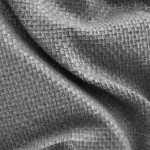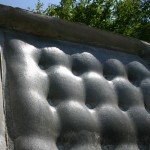

Historically concrete has been treated as either a some sort of monolithic stone or as a kind of lithic wood, and due to the rigid nature of the molds that form it, typically produced in uniform-section prismatic forms.
Textile formworks for concrete construction replace the rigid panels of conventional molds by flexible membranes. Thin strong flexible membranes are capable of resisting, with a minimum amount of material the wet and heavy nature of concrete. When this event happens a complex field of tension geometries is automatically generated in the membrane walls.
This induces the creation of naturally efficient structural curves, new formal possibilities, and excellent surface finishes. Fabric formed concrete can be used to produce simple architectural and structural elements like columns, panels, walls, beams and slabs but can also be use to produce very sophisticated elements unknown to conventional concrete works, like fabric-formed thin shell funicular structures.
These formworks are very efficient because they work in tension, reducing the amount of material that is necessary to resist the high pressures of the wet concrete, resulting in extraordinary light molds.
This efficiency can be extended into the final cast elements by shaping more efficient concrete members. These material savings provide real potential more sustainable architectural and engineering constructions in both low and high capital economies.
This flexibility introduces the creation of a much higher complexity in final cast concrete forms, increasing the value and the quality of a concrete work with out increasing the costs.
Using textiles to shape concrete can change the way we approach this ancient material. When concrete is shaped in flexible molds, it opens a new field of forms. Textiles reveal the nature of concrete as a plastic and fluid material. This also generates a new way of thinking about the design methods in concrete architecture, because the materials involved in this process are turned into active actors in the design and construction.
This construction method can touch a wide range of fields; architecture, structural engineer and sculpture can be mixed through this media, making boundaries difficult to be trace.
images from : C-A-S-T-Centre-for-Architectural-Structures-and-Technology
- Fabric formed concrete wall.
- Geotextile membrane to cast concrete.





